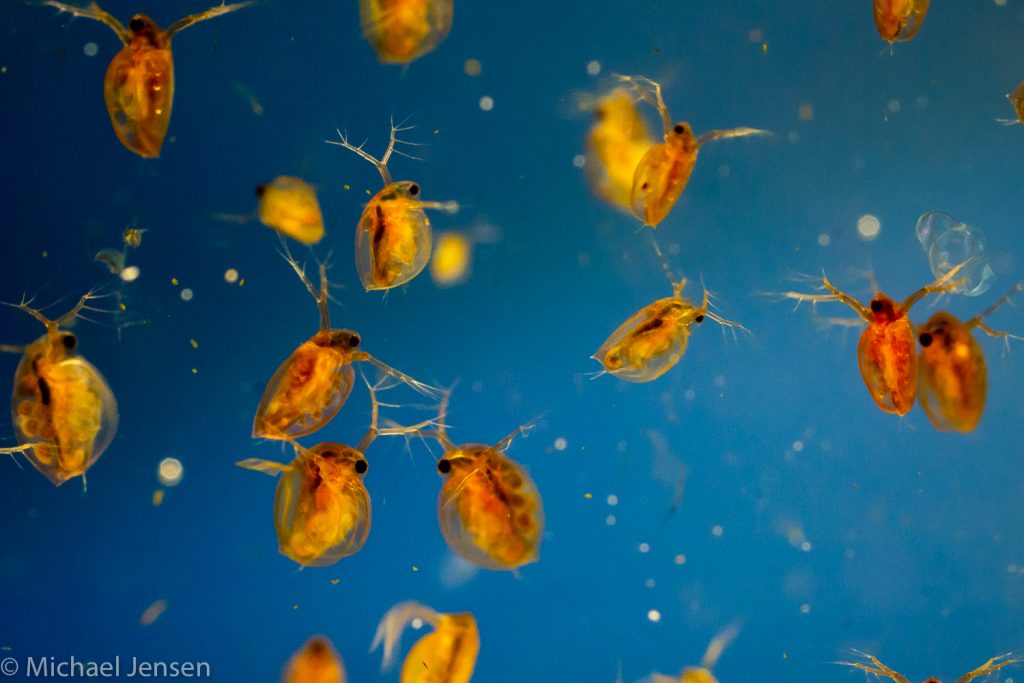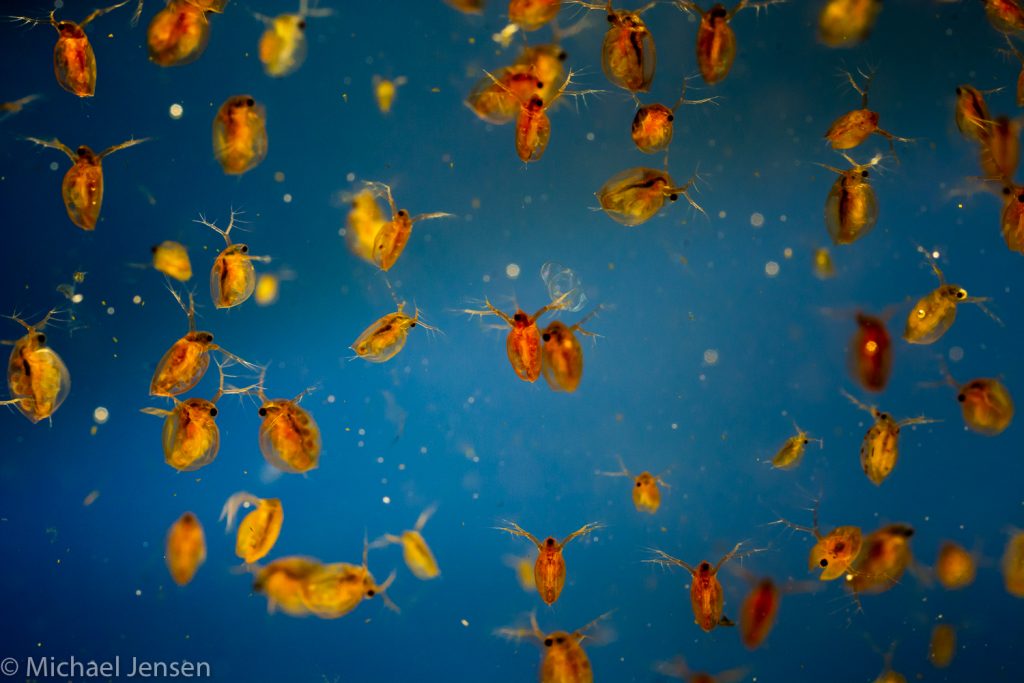Daphnia are just one example of a variety of live food items that are important for your aquarium fish, if you want them to thrive, show their best coloration and breed. And Daphnia can be caught in most small ponds and lakes.
Daphnia are not insects. They are a genus of small planktonic crustaceans. Being just 0.2–5 millimetres in length, they can be difficult to see, when you look into a pond or a lake.
Because of their swimming style, these small crustaceans are called water fleas. They hop and dart in a motion that resembles the movements of fleas.
Where to find daphnia
Daphnia can be found in nearly all still water environments. Ranging from acidic swamps to freshwater lakes and ponds. Even in small ponds, that might dry out during hot summer months.
The two most readily available species of Daphnia are D. pulex (small and most common) and D. magna (large). They are often associated with a related genus Moina, which is even smaller than D. pulex,

Daphnia life circle
Daphnia life circle is kind of interesting. In the spring daphnia hatch from eggs that has survived during winter. These new daphnia produce eggs, that don’t need to be fertilized – and they start to produce lots of new daphnia each day. These spring born crustaceans are all female, and this circle continues until late fall, when the first males are born. With the help of these males, the females produce fertilized eggs, that can live through a cold winter, and be ready to hatch in the spring.
During winter most of the adult daphnia die. But the eggs in the body cavities remain alive and healthy. When the spring sun warms the ponds, they hatch and the circle of life continues.
Important food source
Daphnia reproduce superfast, and they are an important food source for many water living species, counting anything from dragon fly larvae to fish as large as full grown trout. And they are a great live food for your aquarium fish as well.
Dapnia themselves feed on small planktonic bacteria, infusoria and algae.

How to catch daphnia
All you need to catch a supply of these small crustaceans is a fine meshed net, and a plastic bucket.
The best way to avoid bringing any harmful decease home to your aquarium fish is by catching your daphnia in small ponds, where there are no fish. Very small temporary ponds, that may dry out part of the year are ideal, since very few fish species are able to live in those environments.
Gently move the net in circles near the surface, bringing up daphnia without stirring up dead leaves from the bottom is most effective. Daphnia are light sensitive – and will be deeper in the water column in bright light, and rise to the surface in the dark.
Feeding daphnia to your fish
Back home you pour your catch through a fine meshed aquarium net. The clean daphnia can be feed directly to your fish or you can keep them alive in an outdoor pond or a large bucket. Keep in mind that Daphnia needs lots of oxygen though. And cold water holds more oxygen than hot water.
If you need small daphnia for feeding fish fry or nano fish species, you can use a set of seines to sort your catch. In winter there won’t be many small daphnia.

Too many daphnia?
Daphnia populations can bloom and disappear, when conditions, season or weather change. When there is more food, than your fish need – you can freeze some of your catch in small zip-lock bags, and have a reserve in your freeze box.
If you make the bags flat, they freeze up faster, and you can easily break the frozen food in small pieces, which makes feeding a lot easier.
The best way to use daphnia though, is feeding them live to your fish. I put the live daphnia in a plastic box with a bit of clean rainwater – and use a three feet long piece of silicone air tube to distribute the food to my tanks.
Most aquarium fish loves daphnia. I feed them to all of my tetras, barbs, cichlids, killifish and rainbow fish. The great thing about these life food items are: Overfeeding isn’t a problem. The daphnia that aren’t eaten, just stays in the tank, eating up infusoria, bacteria and algae until they are eaten by the fish.
Actually introducing daphnia to a new tank, can speed up the circling process.
More daphnia blogs and films in the making
You can cultivate daphnia in your aquarium room, and keep the supply running smoothly all through the season. But that is a subject for another video, I have in the pipeline.
Affiliate links (Do you want to know more about Affiliate? Read here: https://aquarium.michaeljensens.com/a…
Support My Channel by purchasing things from Amazon through this link (It’s FREE!): https://amzn.to/33uUhXA
My aquarium light: https://amzn.to/2MZBxun
The camera gear I use for making my videos
My DSLR Camera
Nikon D7100 camera
https://amzn.to/2YgHCFs
My Lenses
Nikon AF Nikkor 28-70
https://amzn.to/2JmwWBf
Sigma Macro 105 1:2,8D
https://amzn.to/2YcMHyH
Sigma Macro 50mm
https://amzn.to/2YlYCKT
Nikon AF-S Nikkor 16-85 mm 1:3,5-5,6
https://amzn.to/2LJwHmH
My all weather/underwater camera
Olympus Tough TG-5
https://amzn.to/2Y99ETo
Tripods and stuff
Manfrotto Tripod
https://amzn.to/2LqD266
Gorilla Tripod
https://amzn.to/2LuDT5V
STSEETOP Sun Shade Screen Protector
https://amzn.to/2l69r5L
Bags and backpacks
Pelican Protector Case 1600
https://amzn.to/2Yeyz8c
Photo Bag
https://amzn.to/2PRIDkF
National Geographic Africa Camera Backpack, Brown (NG A5290)
https://amzn.to/2mNBmI4
Microphones and recorders
Røde Link Filmmaker Kit
https://amzn.to/2LuFokz
Zoom H1
https://amzn.to/2Y8t1vY
Microphone Furry Windshield
https://amzn.to/2LEprIK
Gimbal
Feiyutech
https://amzn.to/2JykA9l





